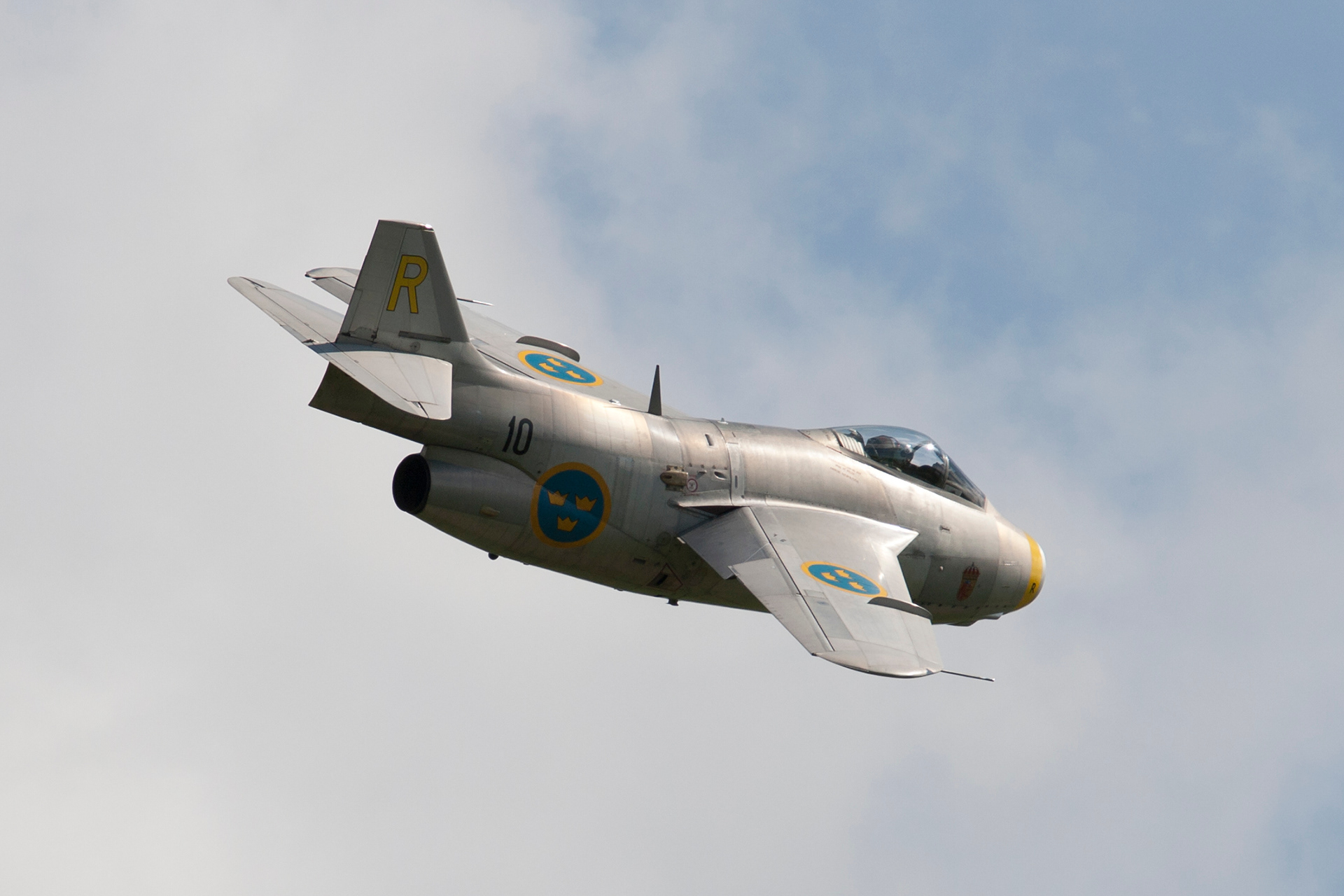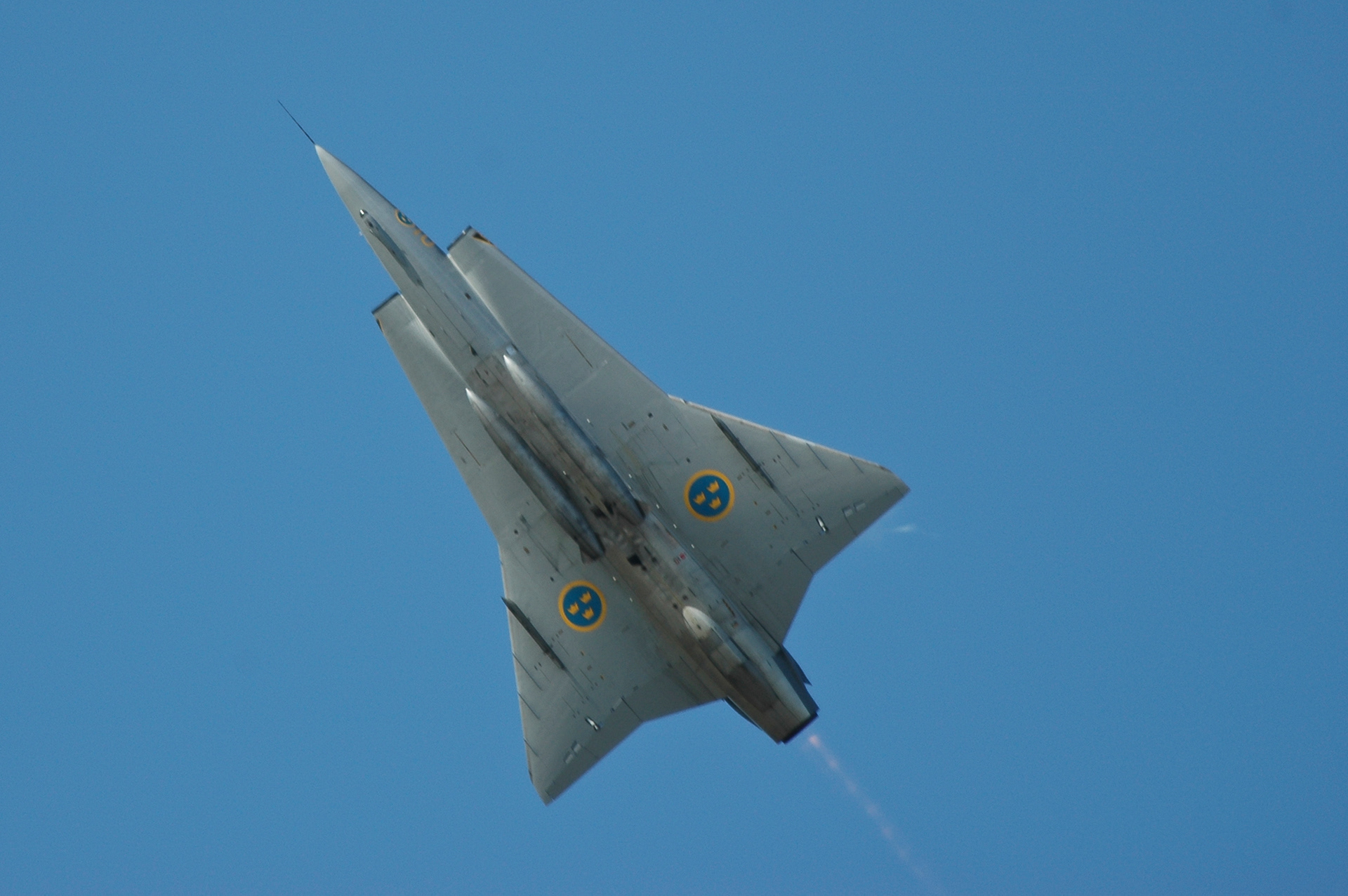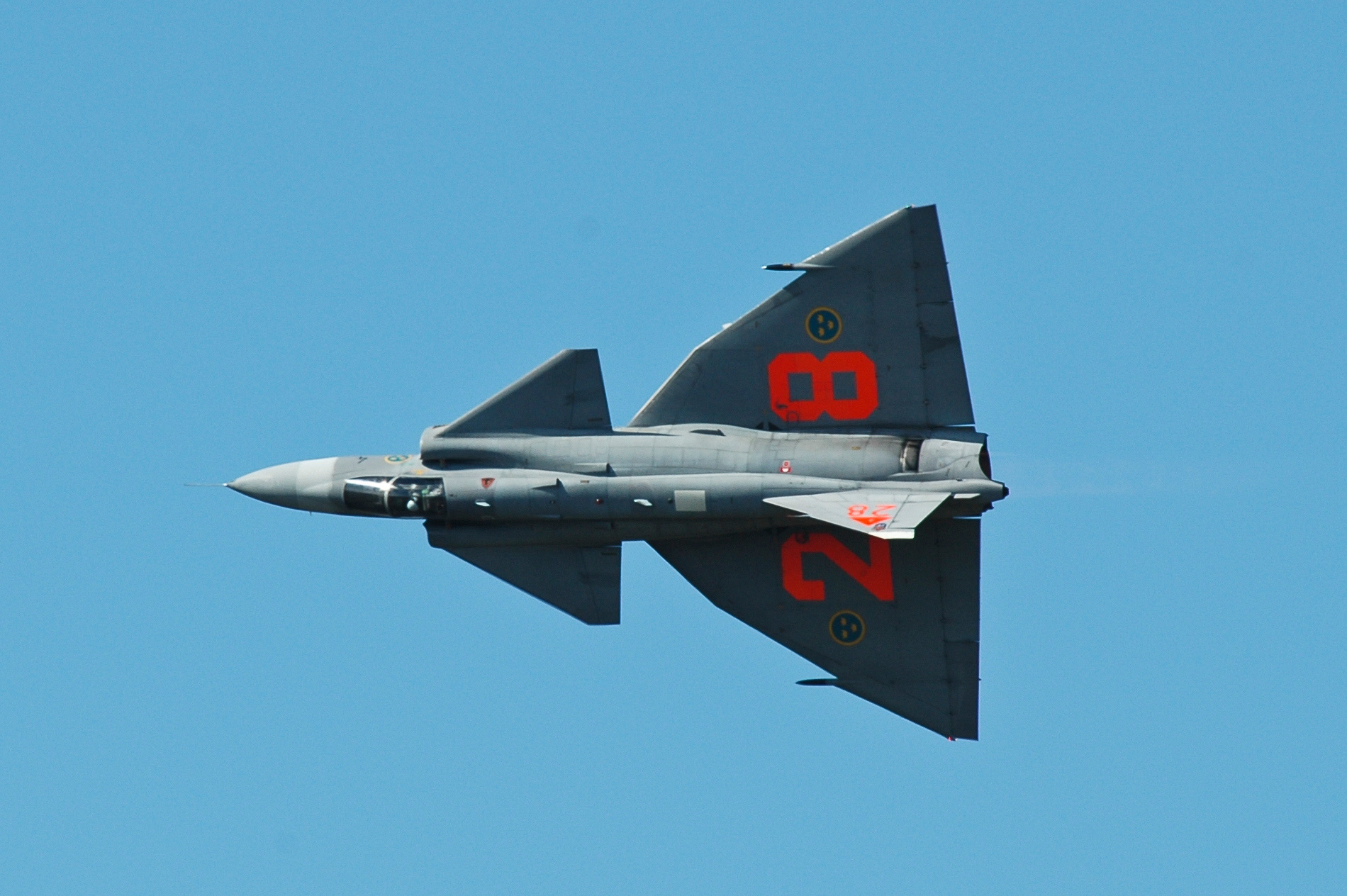A week or two ago a close friend of mine learned that Saab was not only a former car brand, but there are also airplanes bearing the name Saab. "Are they any good?" her question was. Being an aviation enthusiast, and especially after living 15 years in Sweden, I was almost chocked. I guess it is high time for some photos of my Saab collection to feature in an album online. Most of them are a few years old, as I haven't been to any airshows recently.
Below the first series, soon to be expanded.
Saab 29 Tunnan


The Saab 29 Tunnan was the second fighter jet ever produced in Sweden, after the Saab 21R. The Flying Barrel, as it was nicknamed, made its first flight in 1948 and flew in service with the Swedish Air Force from 1951 to 1976. Until the 2000s the aircraft was the only Swedish one to see combat. Sweden dispatched J 29 fighter and S 29C photo reconnaissance versions to Congo in 1961 and 1962, in support of the United Nations peacekeeping force here.
Sweden built a massive 590 Saab Tunnans, which also served with the Austrian Air Force. A single Tunnan still flies with the Swedish Air Force Historic Flight, pictured above.
Saab 91 Safir
The Saab 91 Safir was build as a basic trainer aircraft, and could accommodate three or four people inside. Between 1946 and 1966 an total of 323 Saab Safirs were built: 203 in Sweden and another 120 by De Schelde in Netherlands. The aircraft served with the armed forces of Austria, Ethiopia, Finland, Japan, Norway, Sweden and Tunisia. The Dutch production was mostly aimed at the civilian market, serving not only in the Netherlands, but also in e.g. France and Germany.
Saab 105 / Saab SK60
Despite being developed in the 1960, the Swedish Air Force still uses the tandem two-seat Saab 105, dubbed SK60 in Sweden service, as its primary jet trainer. Saab has been committed to keep the planes flying in 2026 at least. Many of the remaining Saab SK60s in Swedish service still bear camouflage colours, as the type has a secondary ground attack role. Saab built 192 aircraft of the type, 40 served with the Austrian Air Force until December 2020.
Saab 2000
After World War 2, Saab was also relatively successful building two-propeller passenger aircraft. After the Saab 340, a total of 63 Saab 2000s were built. It was the last passenger aircraft that was made by Saab, which moved entirely to military aircraft around the turn of the century.
The Saab 2000, on the photo seen in Braathens livery landing on Stockholm-Arlanda airport in March 2015, accommodates 50 passengers. This was a considerable increase to the 34 in the Saab 340.
Saab lately has used second-hand versions of the type to modify them to airborne early warning and control, maritime patrol or signal intelligence aircraft for the world's armed forces. The same fate some remaining Saab 340s have.
Saab 340 AEW&C / S 100 Argus
As stated above under Saab 2000, civilian Saab 340 has gotten a new life as an airborne early warning and control aircraft (AEW). Operated by a crew of 5 it is the military air traffic and air combat control in the skies, equipped by a the very visible Saab Erieye radar boom on top.
The Swedish Air Force currently operates two S 100s, but the aircraft is up for replacement. Thailand operates two Saab 340B AEWs since October 2012. Poland has purchased two Saab A340 AEWs, which are planned to arrive in 2024. The United Arab Emirates retired two aircraft of the type in 2020.
Saab 32 Lansen
The Saab 32 Lansen has been one of the most versatile aircraft ever in the Swedish Air Force inventory. Although withdrawn from service in 1997, a small number stayed operational all the way to 2020. Two aircraft of the type were instrumental in measuring radiation at high altitudes, and were sent up to take samples from volcanic ash particles in the higher atmosphere in 2010, when an eruption on Iceland caused most transatlantic and continental air traffic in Northern Europe to stand still.
The Lansen's first flight was in 1952 and the primary reason to introduce it from 1956 was to replace older attack (A-types), fighter (J-types) and reconnaissance (S-types) aircraft. It served the Swedish Air Force alone.
Despite its slow looks, the Saab 32 could exceed speeds faster than the speed of sound in shallow dives. Its robust design was also meant to use the attack version as a platform to drop nuclear and chemical weapons, when in the 1950s and 1960s Sweden still had a secret nuclear weapons programme.
Technically the Saab 32 had something left to wish, as about a third of the 450 Lansens produced were lost in accidents, killing 100 pilots and in a single case 7 civilians at a farm where a faulty plane crashed into.
Six Lansens were modified to drag targets across the sky for fighter training. One of these J 32D versions is still flying today, with the Swedish Air Force Historic Flight.
Saab 35 Draken


At some angles more looking like a fast alien attack ship, the Saab 35 Draken is legendary among aviation enthusiasts. When designed in the 1950s, the double delta wing of the aircraft was not proven yet, and the Saab 210 was made to test-fly the principle that was incorporated in the design of the Draken. The name in Swedish means not only dragon, but also kite or even the drake Viking ships. Unknown to many, the Draken could perform a so-called Cobra maneuver at high altitudes.
The Saab 35 was introduced as the prime Swedish combat aircraft from March 1960, with the majority serving in Swedish Air Force service as fighter aircraft (J-type), with 60 reconnaissance types (S 35E) being produced as well - of which 30 were new air frames. In total, 651 Saab 35 Drakens rolled out of the production plant in Linköping and also served with the air forces of Finland, Denmark and Austria. The latter was the last one to retire the type in 2005. A small number of Drakens stay airworthy and fly with the Swedish Air Force Historic Flight; a few apparently fly with civilian operators in the United States - where 6 Drakens were used by the National Test Pilot School.
Saab 37 Viggen



The premier combat aircraft of the Swedish Air Force during the 1980s and 1990s was the Saab 37 Viggen, with "vigg" meaning the thunderbolt strikes by the Norse God Thor as well as a fast diving duck common in Sweden.
Like with the Draken, the Viggen had a radical new wing design, with the horizontal stabilizers (small wings) often seen on the side of the tail of aircraft moved forward. After entering service in June 1971, the Viggen was probably the best combat aircraft flying in Europe - being the first with a decision making computer and integrated circuits. The status it kept for at least 10 years when NATO nations caught up with the Panavia Tornado and newer F-16 models. Its aircraft design has been copied by modern-day fighter jets like the French Rafale and the pan-European Eurofighter Typhoon. Rivaled by only the newer Saab Gripen, the Viggen could be maintained by a small ground crew of five (conscript) soldiers.
All 329 produced Viggens served with the Swedish Air Force alone, until the last operational flight took place in June 2007. The Swedish Air Force historic flights keeps a few in its (flying) collection).
Saab 39 Gripen (JAS 39A/B and JAS 39C/D)
The first 5th generation multi-role fighter of western nations is the Saab 39 Gripen. Despite its first flight in December 1988, it took eight years to introduce the first aircraft to front-line service in 1996. An illustration of how complex modern-day fighter jets have become. Initial problems with the electronic flight control system had to be overcome, for which Saab got some help from US Lockheed. The similar canard wings as the Viggen aircraft, help the Gripen flying at low speeds. Like previous Swedish aircraft, the Gripens need to be able to operate from country roads during war time. Great handling at lower speeds are handy for that.
Technically the Gripen has a modular design, meaning many parts can be quickly exchanged by a small ground crew of 4 or 5, and have the plane back in the air in 10 to 15 minutes. Compared to other modern fighter jets the Saab 39 Gripen is cheap to fly, with about EUR 3,200 per flight hour*. For the popular US-made F-16 this is roughly EUR 5,000*. Other Western designed 5th generation combat jets are much more expensive, with an estimated EUR 11,000* for the French Dassault Rafale, for the Eurofighter Typhoon EUR 12,500* and for the Lockheed F-35A about EUR 15,000* per flight hour.
After having produced 204 Gripen single-seaters (A) and two-seaters (B), Saab started modernizing the Swedish design to NATO standard. These were also offered for export and currently fly with the air forces of the Czech Republic (14, since 2016), Hungary (14, since 2017), South Africa (26, delivered between 2008 and 2016) and Thailand (12 delivered in 2016). Three Swedish Gripens and one Thai Gripen have crashed since the start. Two of the Swedish Gripens due to development issues in the beginning, a third due to a technical flight suite issue.
The Swedish Air Force officially operates 98 Gripens, comprising 74 JAS 39C single-seaters and 24 JAS 39D two-seaters. Most of the air frames are upgraded A and B types. They have been upgraded to NATO standards and many Swedes simply calls them JAS, after "Jakt-, attack- och spaningsflygplan" (Fighter, attack and reconnaissance airplane).
* "Höga flygtimkostnader? Inte med Gripen" in Flygrevyn, No. 8, 2021
Saab 39 Gripen-E/F (JAS 39E/F)
The Saab 39 Gripen-E/F are larger, more capable further developments of the C and D versions. Initially called the Saab 39 Gripen NG (Next Generation) the two-seat demo plane made its first flight in May 2008, reaching supercruise flight of Mach 1.2 (faster than sound) in 2009.
The Gripen-E/F has a better US-made General Electric engine, can carry more weapons, has 40% higher fuel capacity and an extended combat range without inflight refuelling of 1,300 kilometers (810 miles). A new radar, improved avionics and an advanced electronic suite reportedly makes it possible for the Gripen-E/F to even detect stealthy fighter jets like the American F-35 or Russian Su-57.
The Swedish government has ordered 60 JAS 39E/F Gripens, initially to replace the older C and D versions. But after the Russian full-scale invasion of Ukraine, Stockholm is shifting to augmenting the older fleet with the newer Gripen-E and -Fs.
Brazil has ordered 33 Gripen E/Fs, with its indigenous Embraer doing most of the production of the planes designated F-39E/F in Brazilian Air Force. The Latin American country is the first to field the Gripen-E in its front-line squadrons, with the final aircraft expected by 2026.